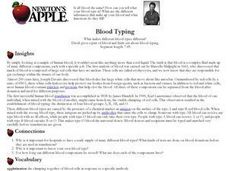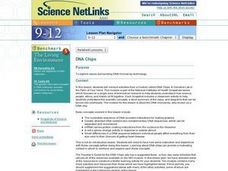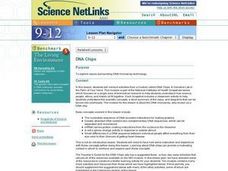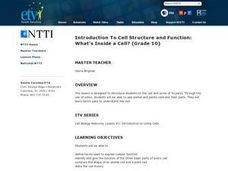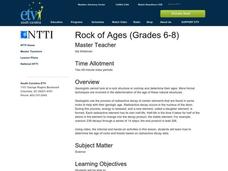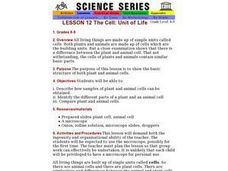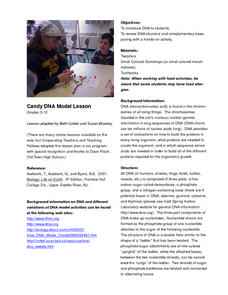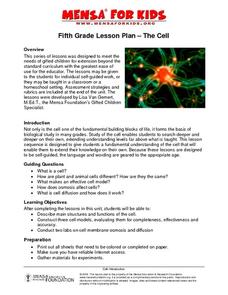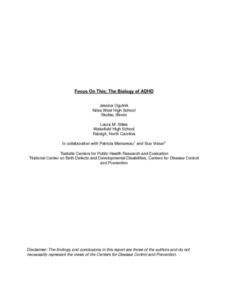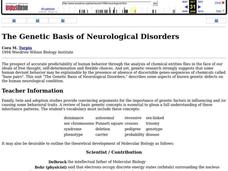Curated OER
What's Your Type
Young scholars record their blood types on a class graph and calculate the potential number of blood donors for each group.
Curated OER
DNA Chips
High schoolers discover what they need to know about DNA chips. They extend this knowledge to analyze gene expression data to diagnose two kinds of leukemia.
Curated OER
DNA Chips
Students explore issues surrounding DNA microarray technology. They focus on a single area of biomedical research to help them explain how science, people, ethics, and history all fit together. They analyze gene-expression data.
Curated OER
SURVIVING A COSMIC INVASION
Students read periodicals relating to radioacitivity and interpret a Geiger Counter. They work in small groups, share information and help each other explain the Geiger Counter. They discover the relationship distance to...
Curated OER
Introduction To Cell Structure and Function: What's Inside a Cell?
Tenth graders are introduced to the cell and some of its parts. Through the use of video, 10th graders see animal and plants cells and their parts. They learn terms used to explain the cell.
Curated OER
Rock of Ages
Students use a video, the Internet and hands-on activities to explore how to determine the age of rocks and fossils based on radioactive decay data.
Curated OER
Atom and Eve
Students research and define an atom using a concept map. They design and create a model of an atom, labelling all the parts, and write a journal entry.
Curated OER
Edible Cells
Eighth graders construct edible models of a plant cell and an animal cell and state the functions of the organelles. They are to write a short sentence describing the function of each organelle.
Curated OER
All Aboard for Protein Synthesis
Fourth graders walk through the process of transcription and translation to demonstrate and explain protein synthesis. They utilize a worksheet imbedded in this plan to guide their role play.
Curated OER
The Cell: Unit of Life
Students identify the parts of plant and animal cells, how samples can be obtained and what the differences are.
Curated OER
Creating an Autobiography
Students create technology based portfolios for others to use as a pattern for assessment. They make a "Personal Autobiography Page" to start the portfolio.
Curated OER
Cell Cookie Lesson Plan
Students review the structure and fuctions of plant and animal cells. They use various types of materials such as sugar cookies and cake frosting for this instructional activity.
Curated OER
Candy DNA Model Lesson
Young scholars explore DNA structure using materials such as Twizzlers, small colored gumdrops and/or toothpicks.
Curated OER
Anticodons And Amino Acids Game
Learners examine the process of protein synthesis. In small groups, they select an index card, and translate the DNA to an amino acid, and define the words on an anticodon/amino acid chart.
Curated OER
What Are the Most Recent Developments in Animal and Human Cloning?
Students research the developments of animal and human cloning. They report their findings to the class. They write journal entries as well.
Curated OER
How does Nuclear Fission differ from Nuclear Fusion?
Pupils examine concepts of nuclear chemistry. They compare and contrast the topics of nuclear fission and nuclear fision. They predict the outcome of reactions based on the types of emissions and reactants.
Curated OER
The Cell
Tenth graders explore the parts of a cell. In pairs, classmates construct a model of a eukaryotic cell, detailing its morphology and function. With the use of computer technology, 10th graders create cell book for middle schoolers. ...
Curated OER
Energy Levels and Electron Configurations
Twelfth graders investigate the proper filling order of electrons in the energy levels of an atom. They practice how to "read" these occupied energy levels as electron configurations and demonstrate their understanding through creative...
Curated OER
Balancing Chemical Equations
Ninth graders explain how atoms and molecules form different substances during chemical reactions and how these processes require losing, gaining or sharing electrons. They correctly write chemical formulas and show how a balanced...
Curated OER
Atomic Structure and Quantum Theory
Students are introduced to the structure of an atom and Dalton's atomic theory through a short video and mini-lecture. They also take a look at the weight of mass and become familiar with the idea of quantum theory
Curated OER
Physicists or Philosophers?
Trace the sequential process of the developing theories of atomic structure in the early 20th century, show, in historical development, how scientists "know" things, how experiments are set up and how interpretations are drawn from them,...
Curated OER
The Biology of ADHD
Students investigate the biology of ADHD and its implications upon the formation and treatment of the disease. They draw and label the parts of a neuron. Also, they describe the neurotransmission cycle. Students create a list of pros and...
Curated OER
Biology - Life Cycles Game
High schoolers develop a working vocabulary of terms related to the life cycle. In small groups, students play the life cycle's game which consists of matching and defining vocabulary. Directions for creating the game board are...
Curated OER
The Genetic Basis of Neurological Disorders
Young scholars explore neurological disorders. They examine the presence and absence of discernible genes. Students describe neruological diseases and draw faces of affected persons. They play a human neurology disorders learning game.
Other popular searches
- Cell Nucleus
- Atomic Nucleus
- Comet Nucleus
- Nucleus Dna Replication
- Nucleus of Cells
- The Nucleus
- Nucleus Radioactivity
- Condensation Nucleus
- Nucleus Discovery
- Chromatin Nucleus
- Nucleus and Human Body
- Nucleus Partners
